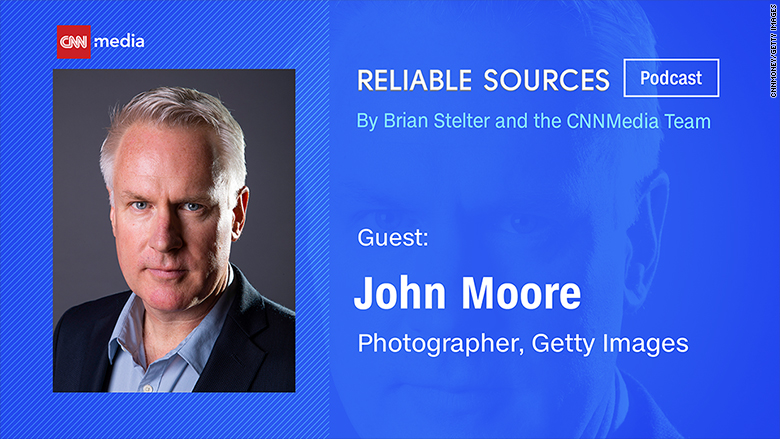
Getty photographer John Moore took a photo that has become the symbol of the immigration debate in America.
The image of a Honduran toddler crying while her mother is being searched and detained in McAllen, Texas, has been featured in stories by news organizations, including CNN.
USA Today said the photo has "become a national symbol of the heartbreak some families are facing as they enter the U.S." NPR said the image "breaks through and captures the essence of a story that we've all been hearing about." CNN's headline reads, "This 2-year-old has become the face of 'zero tolerance.'"
But Moore's work also represents something more for journalists: media access to government affairs.
Moore, a Pulitzer Prize-winning photographer who's covered immigration for Getty for 10 years, and this week's guest on the Reliable Sources podcast, told CNN's Brian Stelter that he has gone into the field with border patrol agents "probably at least 50 different days." He has also accompanied immigrants on different parts of their journeys, including riding on top of trains to reach the border, he said.
Listen to the whole podcast here:
Moore said he was with an agent who was taking him around the Rio Grande on the night he took the now-iconic photo of the girl. He said he has no complaints about how he was treated by border patrol.
"I find most of them very, very professional in their work with me," Moore said of the agents. "And I've had extraordinary access over time."
But this isn't the case for most journalists documenting the immigration crisis. The government has gone to great lengths to keep the media at bay amid news that migrant children are being separated from their parents at the border and sent to detention centers.
Related: This is why there are so few pictures of migrant children
Trump signed an executive order on Wednesday ending the separation of families, but not his "zero tolerance" immigration policy. There is nothing in the executive order about reuniting the children who have already been separated from their parents.
Only a handful of tours of the detention centers have been offered to the press. Yet journalists weren't allowed to record anything on the tours. Instead, the U.S. Customs and Border Protection gave out photos for outlets to use.
Some, like CNN and the Washington Post, have used the government photos with attribution. Notably, the New York Times declined to use the photos.
On Wednesday, the National Press Photographers Association called for news organizations not to publish handout photos. It also asked for politicians who visit the facilities to "insist on being accompanied by visual journalists and to insist that Immigration and Customs Enforcement permits unfettered access to those facilities for all journalists."
"This is unacceptable," reads a staff report on the NPPA's website. "We believe that access to those facilities by journalists is both appropriate and warranted. The nation should not be relegated to relying solely on governmental depictions when it comes to matters of public concern."
Moore mentioned to Stelter that he received access to the McAllen facility in 2014, and that he was able to photograph children inside.
"Of course, that was under a different administration, the Obama administration, which also held undocumented children," Moore said. "In many cases, they were undocumented minors who had come up on their own or with smugglers."
Moore photographed the toddler on June 12, the same day as Trump's summit in Singapore with Kim Jong Un.
The border trip was "pre-planned," Moore said, so "I didn't really know what I would get out of it. And even when I took the pictures that have gotten so much attention, I didn't realize they would touch people the way they have."
Moore's photo of the toddler was used on the cover of Time magazine this week, superimposed with a picture of Trump and the words "Welcome to America." Reports soon surfaced, citing the girl's father and CBP, who said she was not separated from her mother. Right-wing media and Trump allies jumped on the story, using it to bolster arguments of "fake news."
Time stands by the cover. And Moore told CNN he never claimed the girl was taken away from her mother. He also says he was not involved in Time's cover process.
"There were lots of separations happening at the time I was down there. I think it's possible that if everyone focuses on the issues of, you know, 'Was the Time Magazine cover good? Was it not good? Et cetera, et cetera,' it gets people very far away from the main issue," Moore said. "People are being detained almost in perpetuity during very long proceedings for asylum cases. And so I think that's a much more important story."


